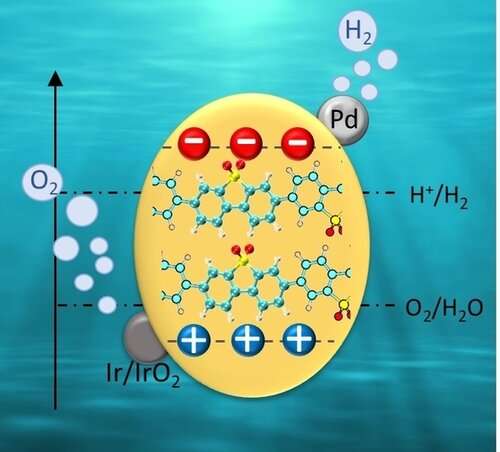
Research led by the University of Strathclyde suggests that solar energy can be accessed and converted into hydrogen—a clean and renewable fuel.
Greenhouse gas emissions need to be significantly reduced to avoid potentially catastrophic effects of climate change, with access to clean and affordable energy needed to eliminate our reliance on fossil fuels. The U.K. Government plans to replace fossil fuels through the use of hydrogen, a storable fuel.
Green hydrogen
Most hydrogen is still made from natural gas, producing greenhouse gasses, and green hydrogen production is urgently needed. Green hydrogen is produced from water using a photocatalyst—a material that drives the decomposition of water into hydrogen and oxygen using sunlight.
The study, “Photocatalytic overall water splitting under visible light enabled by a particulate conjugated polymer loaded with iridium” is published in Angewandte Chemie International Edition, a journal of the German Chemical Society. It suggests that using a photocatalyst under simulated sun light facilitates the decomposition of water when loaded with an appropriate metal catalyst—in this case iridium.
When used in a fuel cell, hydrogen does not emit any greenhouse gasses at the point of use and can help decarbonize sectors such as shipping and transportation, where it can be used as a fuel, as well as in manufacturing industries.
Solar energy study
Principal investigator Dr. Sebastian Sprick, from Strathclyde, said: “An abundant renewable energy resource to address the challenge of sustainable energy exists in the form of the sun, with the energy reaching Earth’s surface eight thousand times greater than the entire annual global energy need of our societies.
“The reported photocatalyst can access solar energy through energetically unfavorable processes to generate a storable energy carrier in the form of hydrogen from water. The hydrogen then can be converted cleanly into electricity in a fuel cell with water being the only side-product.
This is a significant step forward for us as previous systems have relied on using so-called sacrificial reagents to drive the reaction. Sacrificial agents are the electron donors which reduce the recombination tendency of electrons and accelerate the rate of hydrogen generation. Although these allow us researchers to understand systems, they made them energy-negative.
“This study provides a way forward to optimize further as it is not sacrificial. The photocatalysts (polymers) are of huge interest as their properties can be tuned using synthetic approaches, allowing for simple and systematic optimization of the structure in the future and to optimize activity further.”
Researchers say another potential advantage is that polymers are printable, allowing the use of cost-effective printing technologies for scale up—just like newspaper printing.
Dr. Sprick added: “This will also be important to produce hydrogen at scale to address climate change effectively.”
Hydrogen fuel cell, transportation firm to move HQ to Ohio
Yang Bai et al, Photocatalytic Overall Water Splitting Under Visible Light Enabled by a Particulate Conjugated Polymer Loaded with Palladium and Iridium, Angewandte Chemie International Edition (2022). DOI: 10.1002/anie.202201299
Citation:
Study suggests solar energy can be cleanly converted into storable hydrogen fuel (2022, May 5)
retrieved 5 May 2022
from https://techxplore.com/news/2022-05-solar-energy-cleanly-storable-hydrogen.html
This document is subject to copyright. Apart from any fair dealing for the purpose of private study or research, no
part may be reproduced without the written permission. The content is provided for information purposes only.
Stay connected with us on social media platform for instant update click here to join our Twitter, & Facebook
We are now on Telegram. Click here to join our channel (@TechiUpdate) and stay updated with the latest Technology headlines.
For all the latest Technology News Click Here
For the latest news and updates, follow us on Google News.
